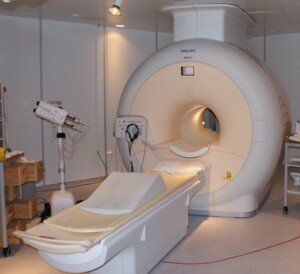Are there medical conditions that an MRI would make difficult to see if the patient were obese? How much fat can interfere with an MRI image?
“MRI machines will have some of the same limitations as a CT scanner with patient size [e.g., not being able to fit in the scanner] and table weight limitations,” begins Brett Mollard, MD, a board certified diagnostic radiologist who specializes in abdominal and chest imaging and nuclear medicine.
“Obesity otherwise does not have a significant impact on MRI imaging ability or exam quality.
“Most MRIs of the abdomen and pelvis are looking at deep structures more central within the body such as the liver, pancreas and kidneys, and therefore, the area of the patient being imaged will be fairly central in the field of view of the scanner.”
In other words, for someone obese enough, portions of their abdomen could be outside the scanner’s field of view – rendering those areas unable to be imaged.
But since an MRI would likely be reading centrally located structures, the spreading out of the waistline wouldn’t matter.
“Since MRI uses powerful magnets, gradient coils and radio waves, it isn’t affected by patient size in the same way as CT.”
What issues can negatively affect MRI imaging?
Whether you’re obese or not, there are other issues you need to be aware of before undergoing an MRI.
“The main issues we run into with MRI are: contraindications due to hardware or implantable devices (e.g., pacemakers), artifact from any metal within the patient such as surgical clips, difficulty following breath-hold commands (some sequences may take several minutes and require multiple, consistent breath-holds), and a strange artifact seen in patients with a large volume of ascites in patients imaged on stronger magnets (typically 3 Tesla scanners),” explains Dr. Mollard.
“We generally have these patients scanned on a 1.5 Tesla scanner and may have some of the ascites fluid drained prior to the MRI scan to maximize image quality.”
 Brett Mollard, MD, completed his residency in diagnostic radiology and nuclear medicine at the University of Michigan where he served as Chief Resident. He subsequently completed a fellowship in abdominal imaging at the University of California, San Francisco (UCSF). He currently works in private practice.
Brett Mollard, MD, completed his residency in diagnostic radiology and nuclear medicine at the University of Michigan where he served as Chief Resident. He subsequently completed a fellowship in abdominal imaging at the University of California, San Francisco (UCSF). He currently works in private practice.
 Lorra Garrick has been covering medical, fitness and cybersecurity topics for many years, having written thousands of articles for print magazines and websites, including as a ghostwriter. She’s also a former ACE-certified personal trainer.
Lorra Garrick has been covering medical, fitness and cybersecurity topics for many years, having written thousands of articles for print magazines and websites, including as a ghostwriter. She’s also a former ACE-certified personal trainer.
.









































